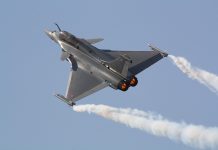
Possible Deployment of Italian B1 Centauro Tank Destroyers to Ukraine
Unverified reports emerging from Italian social media circles indicate that Italy may be preparing to transfer B1 Centauro wheeled tank destroyers to Ukraine. While official confirmation from Rome remains absent, imagery purportedly showing a convoy of these vehicles in transit has fueled speculation about their potential deployment. If confirmed, such a move would mark a notable escalation in Italy’s military support for Ukraine.
Discussions regarding the potential transfer of B1 Centauros have circulated since 2022. In April of that year, Italian media, including La Repubblica, reported that the Ministry of Defense was evaluating additional military aid to Ukraine, with the Centauro among the assets under review. The decision was reportedly influenced by a need to reinforce Ukrainian armored capabilities without significantly impacting Italy’s own force readiness. In May 2023, footage surfaced online depicting a train loaded with Centauro vehicles moving through southern Italy, prompting theories that they were en route to Ukraine via European logistical networks. Despite the presence of Italian markings, a lack of official statements left the matter unresolved. Some analysts speculated that decommissioned units, previously held in storage, could be repurposed for transfer.
Italy has a history of discreet military aid deliveries, as evidenced by the unpublicized transfer of M109L self-propelled howitzers. The absence of formal announcements regarding the Centauro’s potential deployment is consistent with this pattern. However, the latest reported sightings have reignited the debate on whether these vehicles are indeed bound for the Ukrainian theater.
B1 Centauro: Capabilities and Strategic Relevance
The B1 Centauro is a highly mobile tank destroyer developed in the 1980s by a consortium of Iveco Fiat and Oto Melara, designed to provide rapid-reaction forces with an anti-armor capability. Entering service with the Italian Army in 1991, approximately 400 units were produced before manufacturing ceased in 2006.
Equipped with a 105mm rifled gun capable of firing NATO-standard munitions—including armor-piercing fin-stabilized discarding sabot (APFSDS) rounds—the Centauro offers firepower comparable to early main battle tanks. Some variants, such as those exported to Oman, feature a 120mm gun, though Italy’s fleet primarily retains the original 105mm configuration. Secondary armament consists of a coaxial 7.62mm machine gun and an additional pintle-mounted weapon for anti-aircraft or suppressive fire roles.
The Centauro is powered by an Iveco V6 turbocharged diesel engine generating 520 horsepower, allowing it to reach speeds exceeding 100 km/h (60 mph) on roads. Its operational range of approximately 800 km (500 miles) enhances its strategic mobility, making it well-suited for rapid deployment across extended frontlines. While its base armor provides protection against 14.5mm projectiles and artillery shrapnel, additional modular armor upgrades improve survivability against 25mm to 30mm threats. The vehicle’s fire control system, integrating thermal imaging, a laser rangefinder, and a ballistic computer, enables accurate targeting in both day and night conditions.
Tactical Implications for Ukraine
If integrated into Ukraine’s armored formations, the B1 Centauro would complement existing Western-supplied tanks, such as the Leopard 1 and Leopard 2, by providing a fast, mobile fire-support platform. Unlike tracked main battle tanks, which face logistical and terrain-related constraints, the Centauro’s wheeled design allows for rapid redeployment along road networks, a critical factor given Ukraine’s expansive and diverse battlefield conditions.
Weighing approximately 24 tons, the Centauro offers a balance between firepower and mobility, making it a viable option for hit-and-run tactics, reconnaissance-in-force missions, and fast-moving counteroffensive operations. However, its lighter armor renders it vulnerable to modern anti-tank guided missiles (ATGMs) such as the Russian Kornet and Western-supplied Javelin systems. As such, its effectiveness would likely depend on strategic employment, leveraging mobility to avoid protracted engagements with heavily armored adversaries.
Expert Assessments and Strategic Outlook
Italian defense analysts have weighed in on the potential transfer. Gianandrea Gaiani, editor of Analisi Difesa, noted in 2023 that the transfer of B1 Centauros would align with Italy’s discreet approach to military assistance, particularly given the introduction of the next-generation Centauro II into Italian service. Military historian Paolo Mauri emphasized the Centauro’s suitability for Ukraine’s operational environment, while cautioning that its light armor remains a critical vulnerability. Defense industry consultant Nicholas Drummond suggested that the Centauro’s performance in Ukraine could reinforce the case for wheeled tank destroyers in modern conflict scenarios.
As speculation mounts, the potential deployment of B1 Centauros to Ukraine remains an issue of strategic interest. Whether these vehicles have already been transferred or are merely being repositioned within Italy, the discussion underscores the evolving nature of European military assistance to Kyiv and the shifting dynamics of armored warfare in the ongoing conflict.




